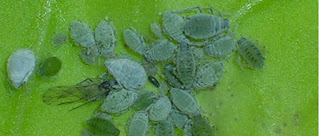Aphid, Black Bean
Host Plants:
In the garden: Viburnum, dahlia, nasturtium and a number of ornamental garden plants
On Crops: Bean, beet, celery and many other vegetable garden plants
Where Found:
Europe and isolated areas where celery is grown commercially
Description:
These are dark green to dark gray soft-bodied insects about two millimeters long. They are often found in dense clusters on tender new growth.
Damage:
Black bean aphids are usually visible on plants because of their contrasting color. Aphids feed by sucking plant juices, so infested growth is often yellowed and curled. In addition to the direct damage aphid feeding does to plants, aphids can transmit several diseases.
Preventing Problems:
Check plants often for early outbreaks. Clip off and compost stems holding aphid clusters. Encourage beneficial insects including lady beetles, syrphid flies, and lacewings, which are important aphid predators.
Managing Outbreaks:
In small outbreaks, a high pressure spray from the garden hose can help remove aphids from plants. Follow up with two applications of insecticidal soap, one week apart. Be sure to apply the soap spray to leaf undersides and crevices.
Tips:
Lady beetles and their larvae are great beneficial insects to welcome into your garden. Ants tend to be attracted to the honeydew left by aphids, so ant activity can often lead you to aphid colonies.
Aphid, Cabbage
Host Plants:
On Crops: Brussels sprouts, cabbage, kale, rutabaga, turnip
Where Found:
Worldwide, wherever cabbage family crops are grown
Description:
Cabbage aphids are gray-green with a whitish waxy coating. They are often found in dense clusters on tender new growth. While present in spring and summer, populations increase by late summer and persist well into the autumn season.
Damage:
Cabbage aphids have good camouflage, and may not be seen until they have become quite numerous. In addition to the aphids themselves, look for black deposits of honeydew where the aphids have been feeding. Late-maturing Brussels sprouts and cabbage are at high risk for damage by cabbage aphids.
Preventing Problems:
Pull up and compost old plants, because cabbage aphids can overwinter in dead plant tissue. Clip off and compost stems holding aphid clusters. Harvest Brussels sprouts often, because sprouts left too long can serve as aphid nurseries. Encourage beneficial insects including lady beetles, syphid flies, and lacewings, which are important aphid predators.
Managing Outbreaks:
In small outbreaks, a high pressure spray from the garden hose can help remove cabbage aphids from plants. Follow up with two applications of insecticidal soap, one week apart. Be sure to apply the soap spray to leaf undersides and crevices.
Tips:
Lady beetles and their larvae are great beneficial insects to welcome into your garden. Ants tend to be attracted to the honeydew left by aphids, so ant activity can often lead you to aphid colonies.
Aphids (General)
Plants:
In the wild: Wild plants, shrubs, hedges and trees
In the garden: Ornamental trees and shrubs, including roses.
On Crops: Most vegetable fruit and ornamental plants.
Where Found:
Worldwide
Description:
Small, soft-bodied pear-shaped insects less than three millimeters long are usually aphids. Depending on species and plant, aphids may be beige, green, yellow or almost black. They tend to congregate in groups on new growth or in leaf crevices. See also black bean aphids and cabbage aphids.
Damage:
There are many symptoms of aphid damage, including decreased growth rates, mottled leaves, yellowing, stunted growth, curled leaves, browning, wilting, low yields and, eventually, death. Along with the loss of plant juices from direct feeding, aphids can spread diseases.
Preventing Problems:
Check plants often for early outbreaks. Clip off and compost stems holding aphid clusters. Encourage beneficial insects including lady beetles, syrphid flies, and lacewings, which are important aphid predators.
Managing Outbreaks:
In small outbreaks, a high pressure spray from the garden hose can help remove aphids from plants. Follow up with two applications of insecticidal soap, one week apart. Be sure to apply the soap spray to leaf undersides and crevices.
Tips:
Lady beetles and their larvae are great beneficial insects to welcome into your garden. Ants tend to be attracted to the honeydew left by aphids, so ant activity can often lead you to aphid colonies.







0 comments
إرسال تعليق